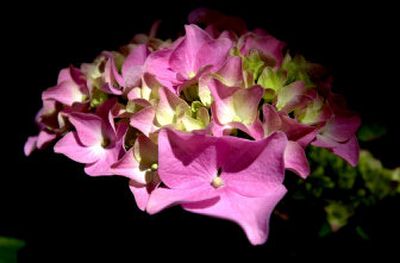Hydrangeas worth the work

Growing hydrangeas in the Inland Northwest seems to be a major challenge for gardeners. I don’t know how many times I’ve heard gardeners say they planted one and it never bloomed.
The hydrangea most people are referring to is the big leaf hydrangea (Hydrangea macrophylla). Its enormous blue or pink flowers are hard to resist, especially if you are originally from coastal Washington, Oregon or the South and know what really nice plants they can be.
Sadly, the big leaf hydrangeas don’t bloom reliably here because they are at their hardiness limit in the Spokane area; USDA Zone 5b (-10 to -15 degrees). The reason is pretty straightforward. The flowers bloom on old wood or wood that grew the previous season. When the over-wintering wood is treated to a typical Inland Northwest winter, more often than not, buds on the old-wood freezes and kills them and any chance of flowers the following summer.
So what is a gardener to do when you absolutely have to have one of these beauties? Try some of the other varieties of hydrangeas that are much hardier and just as colorful, instead.
If blue flowers are a must, then among the hundreds of varieties of macrophyllas are at least two varieties that produce flowers reliably. They have the ability to produce flowers on new wood. This means that unless the entire plant is killed by the winter, the new spring growth will produce flower buds.
The variety Endless Summer has been marketed quite heavily since its introduction in 2004. A medium-sized plant that produces the traditional blue or pink flowers, depending on the soil’s pH, was a sport or mutation of an ordinary hydrangea discovered at a nursery in the Midwest several years ago. While it hasn’t experienced a real Inland Northwest winter yet, several people I’ve talked to are expecting a heavy crop of blooms this summer.
Another variety that blooms on new wood, and has been around for awhile, is All Summer Beauty, which produces dark blue or pinkish flowers on a compact plant with light green leaves.
Both of these plants still need to be planted in a location sheltered from winter winds, with well-drained soil and some protection from the afternoon sun in the summer. Both can be lightly pruned in late winter, but should not need a lot of pruning.
If you want an even tougher hydrangea, you are in luck. There are several varieties that are hardy to Zone 3. The only catch is that they aren’t blue. The PeeGee hydrangea, or Hydrangea paniculata Grandiflora, is a vigorous, hardy, grower. Its flowers are conical in shape and open in late August. They are a creamy white color that age to a light pink over several weeks. The name PeeGee comes from the initials of its species and variety name paniculata Grandiflora. The flowers are attractive when cut and dried at the end of the season. For best results, give the plant evenly moist soil and some shade from the afternoon sun.
Another great hydrangea for colder areas is Hydrangea arborescens Annabelle (Zone 3). Also known as the Snowball hydrangea, Annabelle has huge white blooms in June and July that can reach 8 inches in diameter and resemble – what else – giant snowballs. The plant can grow to a respectable 4 to 5 feet tall and 3 to 4 feet wide. Because the flowers bloom on new wood, it can be pruned hard in very early spring. It requires an even moisture supply and afternoon shade.
If you want a robust vine for a shady place, look no further than the climbing hydrangea (Hydrangea anomala petiolaris). This stout woody vine is hardy to Zone 5 with glossy, bright green leaves and creamy white flowers in June and July. The plant takes a few years to establish its roots and starts climbing.